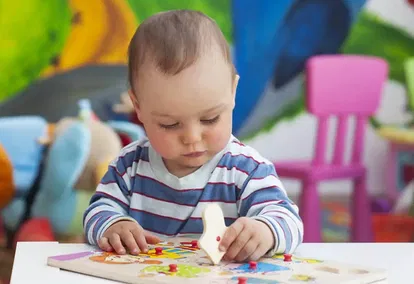
How do Mission Friends leaders teach babies, ones, and twos and meet their needs at the same time?
Babies, ones, and twos have the basic needs of love, trust, acceptance, independence, security, freedom, guidance, and a sense of accomplishment*. As you consistently guide a young child in a loving and patient way, you will be laying a foundation in which these needs will be met. When you teach babies, ones, and twos about missionaries and the monthly Christian Concept Area, you will help them learn about missions and God’s love and plan for all people.
Babies, ones, and twos need hands-on guidance and constant supervision.
Babies will be observing, listening to conversation and songs, looking at books, and playing with toys.
Ones and twos will be busy moving around the room investigating everything and attempting most activities.
Babies, ones, and twos require two leaders for up to 6 little ones. For more than 6 preschoolers, the ratio is 1 teacher for every 3 preschoolers.
Use the suggested guidance tips from Mission Friends Leader.
Some ways to teach Babies, Ones, and Twos.
Choose age appropriate activities from Mission Friends Leader. Provide a variety of activities to meet the various needs of preschoolers in your class. Remember that babies, ones, and twos learn as you repeat activities during the month.
Before the session, learn the Bible thoughts and songs so you can intentionally use them during the session. Sing while you change a diaper or say the Bible thought as you help pick up toys.
Get on the same eye level as the babies, ones, and twos you are teaching. That could mean sitting at a table in a child-sized chair, bending over a changing table, sitting on a blanket on the floor, or crawling with a child who is pushing a toy car.
Talk with babies, ones, and twos about God’s love. As often as possible, include a child’s name when talking about God’s love. Simple statements such as God loves Josie or Michael likes to go to church will gently reinforce biblical concepts.
Calmly help babies, ones, and twos to be independent by helping them to do as much as they can for themselves (reach for a toy, stack blocks, etc.) without becoming overly frustrated.
Observe body language and adjust activities as needed. A tired baby might be emotional and unable to enjoy playing with blocks or an overexcited two-year-old could be too full of energy to sit for a long story. Shorten stories, add a movement activity, or sing favorite songs to help young preschoolers adjust.
Be ready to distract or redirect a child who wants what others have. Invite the child to join you in a new or favorite activity, move beside you and play, or look for a different activity to go do together.
Ready, set, go!
Arrive early to set up the room before preschoolers arrive. Be ready with a smile to greet each child and parent.
During the session, focus on preschoolers and what is happening in Mission Friends. Calmly guide preschoolers with love, patience, and joy.
After the session, talk with your co-leaders about what went well and how things could have been better. Use what you learn to be better prepared for future sessions.
Pray for the babies, ones, and twos in your Mission Friends class. Thank God for them and ask for wisdom on ways to best help each one learn.
*Sanders, Thomas and Mary Ann Bradberry, Teaching Preschoolers: First Steps Toward Faith ( Nashville, Tennessee: LifeWay Press, 2005), 17.
by Janora Skeens